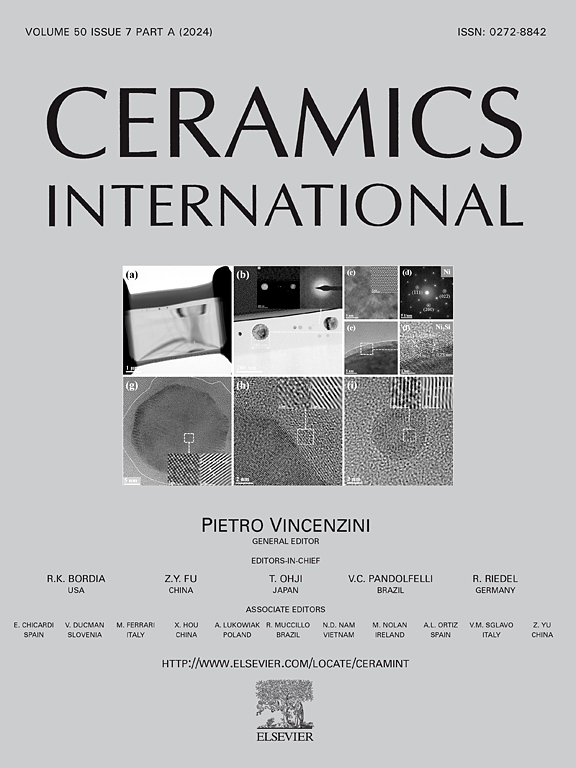Evolution of residual stress of SiCf/Ti17 composites at high temperature evaluated by micro-Raman spectroscopy
IF 5.1
2区 材料科学
Q1 MATERIALS SCIENCE, CERAMICS
引用次数: 0
Abstract
SiCf/Ti17 composites are considered promising lightweight high-temperature structural materials for the aerospace field due to their excellent mechanical properties. However, during the manufacturing process, differences in the coefficients of thermal expansion between various material components inevitably generate thermal residual stresses at the interfaces. These thermal residual stresses can lead to stress concentration and other failure modes, thereby affecting the mechanical properties of SiCf/Ti17 composites. Therefore, it is crucial to systematically study the residual stresses in the interfacial C coating and the W/SiC interfacial regions, as well as the evolution of these stresses at high temperatures. In this study, samples were first subjected to vacuum heat treatment, followed by systematic micro-Raman experiments conducted radially on the fibers. Subsequently, the Raman spectra were subjected to peak deconvolution to obtain precise target peaks. By combining Raman peak shifts with Hooke's law, the evolution of high temperature residual stresses in the C coating and W/SiC interfacial regions were determined. Additionally, changes in the Raman spectral data at different temperatures were analyzed to investigate the variations in the micro-composition of different regions. The results showed that at 850 °C, both the C coating and the W/SiC interfacial region exhibited good mechanical properties and strength retention. However, at 1050 °C, the mechanical properties of both regions gradually deteriorated, with the W/SiC interfacial region showing a sharp increase in compressive stress. At this point, the SiCf/Ti17 composite material may face a risk of failure.
求助全文
约1分钟内获得全文
求助全文
来源期刊

Ceramics International
工程技术-材料科学:硅酸盐
CiteScore
9.40
自引率
15.40%
发文量
4558
审稿时长
25 days
期刊介绍:
Ceramics International covers the science of advanced ceramic materials. The journal encourages contributions that demonstrate how an understanding of the basic chemical and physical phenomena may direct materials design and stimulate ideas for new or improved processing techniques, in order to obtain materials with desired structural features and properties.
Ceramics International covers oxide and non-oxide ceramics, functional glasses, glass ceramics, amorphous inorganic non-metallic materials (and their combinations with metal and organic materials), in the form of particulates, dense or porous bodies, thin/thick films and laminated, graded and composite structures. Process related topics such as ceramic-ceramic joints or joining ceramics with dissimilar materials, as well as surface finishing and conditioning are also covered. Besides traditional processing techniques, manufacturing routes of interest include innovative procedures benefiting from externally applied stresses, electromagnetic fields and energetic beams, as well as top-down and self-assembly nanotechnology approaches. In addition, the journal welcomes submissions on bio-inspired and bio-enabled materials designs, experimentally validated multi scale modelling and simulation for materials design, and the use of the most advanced chemical and physical characterization techniques of structure, properties and behaviour.
Technologically relevant low-dimensional systems are a particular focus of Ceramics International. These include 0, 1 and 2-D nanomaterials (also covering CNTs, graphene and related materials, and diamond-like carbons), their nanocomposites, as well as nano-hybrids and hierarchical multifunctional nanostructures that might integrate molecular, biological and electronic components.
 求助内容:
求助内容: 应助结果提醒方式:
应助结果提醒方式:


